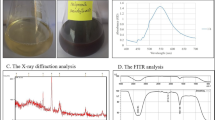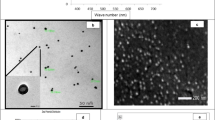Abstract
This study aimed to describe an efficient method for optimized synthesis of gold nanoparticles (Au NPs) by using Eryngium bungei (EB) hydro-alcoholic extract and also to demonstrate its hepatoprotective activity in comparison with a chemically synthesized counterpart in a rat model of acetaminophen-induced acute liver injury. To this end, various parameters were optimized in 12 trials to enhance the yield of gold nanoparticles (Au NPs) synthesized at room temperature. The synthesized NPs were characterized by different methods. In hepatoprotective study, effect of pretreatment with these Au NPs at 100, 200 and 400 mg/kg in comparison with chemically synthesized Au NPs was evaluated in rats with acetaminophen-induced liver injury. The optimal conditions were HAuCl4 at 1 mM, a reaction time of 4 h with 1:9 ratio of plant extract to HAuCl4 which yielded spherical NPs in transmission electron microscopy (TEM) with a size of 53.8 nm in dynamic light scattering (DLS) analysis. The Fourier-transform infrared spectroscopy (FTIR) spectrum of the Au NPs was relatively similar to the extract that indicated various types of functional groups. Pretreatment with Au NPs ameliorated acetaminophen-induced liver injury based on liver function tests. For oxidative stress parameters and pro inflammatory cytokines, the effect of green synthesized Au NPs was more profound than chemically synthesized NPs. In conclusion, the hydro-alcoholic extract from aerial parts of EB can be successfully used for synthesizing Au NPs. Green synthesized Au NPs show more profound anti-oxidant and anti-inflammatory effects than their chemically synthesized counterpart in a rat model of acute liver injury.








Similar content being viewed by others
References
P. Mohanpuria, N.K. Rana, S.K. Yadav, Biosynthesis of nanoparticles: technological concepts and future applications. Nanopart. Res. 10, 507–517 (2008)
Y. Yang, M. Yang, Z. Zheng et al., Highly effective adsorption removal of perfluorooctanoic acid (PFOA) from aqueous solution using calcined layer-like Mg-Al hydrotalcites nanosheets. Environ. Sci. Pollut. Res. (2020). https://doi.org/10.1007/s11356-020-07892-4
Y. Wang, Y. Wang, L. Yu et al., Highly effective microwave-induced catalytic degradation of Bisphenol A in aqueous solution using double-perovskite intercalated montmorillonite nanocomposite. Chem. Eng. J. 390, 124550 (2020)
J. Chen, X. Zhang, F. Bi et al., A facile synthesis for uniform tablet-like TiO2/C derived from Materials of Institut Lavoisier-125(Ti) (MIL-125(Ti)) and their visiblelight-driven photodegradation of tetracycline. J. Colloid Interface Sci. 571, 275–284 (2020)
F. Bi, X. Zhang, J. Chen et al., Excellent catalytic activity and water resistance of UiO-66-supported highly dispersed Pd nanoparticles for toluene catalytic oxidation. Appl. Catal. B 269, 118767 (2020)
R. Teimuri-mofrad, R. Hadi, B. Tahmasebi et al., Green synthesis of gold nanoparticles using plant extract: mini-review. Nanochem. Res. 2, 8–19 (2017)
S. Khan, J. Bakht, F. Syed, Green synthesis of gold nanoparticles using Acerpentapomiccum leaves extract its characterization, antibacterial, antifungal and antioxidant bioassay. Dig. J. Nanomater. Biostruct. 13, 579–589 (2018)
I. Khan, K. Saeed, I. Khan, Nanoparticles: properties, applications and toxicities. Arab. J. Chem. 12, 908–931 (2019)
A.R. Sadrolhosseini, A.S.M. Noor, M.S. Husin et al., Green synthesis of gold nanoparticles in pomegranate seed oil stabilized using laser ablation. J. Inorg. Organomet. Polym. 24, 1009–1013 (2014)
T. Vo, C. Dang, V. Doan et al., Biogenic synthesis of silver and gold nanoparticles from Lactuca indica leaf extract and their application in catalytic degradation of toxic compounds. J. Inorg. Organomet. Polym. 30, 388–399 (2020)
J.C. Mosanen, F. Tacher, Acetaminophen-induced acute liver injury in mice. Lab. Anim. 49, 30–36 (2015)
M.L. Bajt, T.R. Knight, J.J. Lemasters et al., Acetaminophen-induced oxidant stress and cell injury in cultured mouse hepatocytes: protection by N-acetyl cysteine. Toxicol. Sci. 80, 343–349 (2004)
C. Cover, A. Mansuri, T.R. Kinght et al., Peroxidenitrite-induced mitochondrial and endonuclease-mediated nuclear DNA damage in acetaminophen hepatotoxicity. J. Pharmacol. Exp. Ther. 23, 17–51 (2005)
K. Kon, J.S. Kim, A. Uchiyama et al., Lysosomal iron mobilization and induction of the mitochondrial permeability transition in acetaminophen-induced toxicity to mouse hepatocytes. Toxicol. Sci. 117(1), 101–108 (2010)
S.H. Garba, N. Samibo, U. Bala, The effect of the aqueous extract of Kohautia grandiflora on Paracetamol-induced liver damage in albino rats. Niger. J. Physiol. Sci. 24, 17–23 (2009)
M. Khatami, M. Soltaninejad, K. Kaikavoosi, Biosynthesis of gold nanoparticles using Persian clover seed extract. Qom Univ. Med. Sci. J. 10, 22–30 (2016)
S.A. Erdem, S.F. Nabavi, I.E. Orhan et al., Blessings in disguise: a review of phytochemical composition and antimicrobial activity of plants belong to the genus Eryngium. Pharm. Sci. 23, 53 (2015)
J. Turkevich, P.L. Stevenson, J.A. Hillier, study of the nucleation and growth process in the synthesis of colloidal gold. Discuss. Faraday Soc. 11, 55–75 (1951)
C. Beeton, A. Garcia, K.G. Chandy, Drawing blood from rats through the saphenous vein and by cardiac puncture. J. Vis. Exp. 7, 266 (2007)
Directive 2010/63/EU of the European Parliament and of the Council of 22 September 2010 on the protection of animals used for scientific purposes. https://data.europa.eu/eli/dir/2010/63/oj
M.M. Bradford, Rapid and sensitive method for the quantitation of microgram quantities of protein utilizing the principle of protein-dye binding. Anal. Biochem. 72, 248–254 (1976)
H. Borchert, E.V. Shevchenko, A. Robert et al., Determination of nanocrystal sizes: a comparison of TEM, SAXS, and XRD studies of highly monodisperse CoPt3 particles. Langmuir 21, 1931–1936 (2005)
R.M. Silverstein, F.X. Webster, D. Kiemle et al., Spectrometric Identification of Organic Compounds, 8th edn. (Wiley, Hoboken, 2014)
A.D. Dwivedi, K. Gopal, Biosynthesis of silver and gold nanoparticles using Chenopodium album leaf extract. Colloids Surf. A 369, 27–33 (2010)
D. Philip, C. Unhi, Extracellular biosynthesis of gold and silver nanoparticles using krishnatulsi (Ocimumsanctum) leaf. Physica E 43, 1318–1322 (2011)
B. Ajita, Y.A.K. Reddy, P.S. Reddy, Biosynthesis of silver nanoparticles using Plectranthusamboinicus leaf extract and its antimicrobial activity. Spectrochim. Acta A 128, 262–275 (2014)
M. Mohammadhoseini, B. Mahdavi, M.H. Akhlaghi, Characterization and chemical composition of the volatile oils from aerial parts of Eryngium bungei Bioss. (Apiaceae) by using traditional hydrodistillation, microwave assisted hydrodistillation and head space solid phase microextraction methods prior to GC and GC/MS analyses: a comparative approach. J. Essent. 16(5), 613–623 (2013)
S.A. Cumberland, J.R. Lead, Particle size distributions of silver nanoparticles at environmentally relevant conditions. J. Chromatogr. A 1216, 9099–9123 (2009)
H. Jaeschke, Y. Xie, M.R. McGill, Acetaminophen-induced liver injury: from animal models to humans. J. Clin. Transl. Hepatol. 2, 153–161 (2014)
G. Singh, N. Dhadwal, S.L. Harikumar, Experimental models for hepatotoxicity. Asian J. Pharm. Clin. Res. 8, 70–74 (2015)
J.A. Lawson, A. Farhood, R.D. Hopper et al., The hepatic inflammatory response after Acetaminophen overdose: role of neutrophils. Toxicol. Sci. 54, 509–516 (2000)
P. Mazraati, M. Minaiyan, Hepatoprotective effect of metadoxine on acetaminophen-induced liver toxicity in mice. Adv. Biomed. Res. 7, 67 (2018)
M.H. Oueslati, B.T. Lotfi, A.H. Harrath, Catalytic, antioxidant and anticancer activities of gold nanoparticles synthesized by kaempferol glucoside from Lotus leguminosae. Arab. J. Chem. 13, 3112–3122 (2020)
K. Du, A. Ramachandran, H. Jaeschke, Oxidative stress during acetaminophen hepatotoxicity: sources, pathophysiological role and therapeutic potential. Redox Boil. 10, 148–156 (2016)
B.L. Woolbright, H. Jaeschke, Mechanisms of inflammatory liver injury and drug-induced hepatotoxicity. Curr. Pharmacol. Rep. 4, 346–357 (2018)
R.F. de Araújo Júnior, A.A. de Araújo, J.B. Pessoa et al., Anti-inflammatory, analgesic and anti-tumor properties of gold nanoparticles. Pharmacol. Rep. 69, 119–129 (2017)
Funding
Funding for this study was provided by Shiraz University, School of Veterinary Medicine according to Grant Number: 96GCU2M163773.
Author information
Authors and Affiliations
Corresponding author
Ethics declarations
Conflict of interest
Authors declare no conflict of interests.
Additional information
Publisher's Note
Springer Nature remains neutral with regard to jurisdictional claims in published maps and institutional affiliations.
Rights and permissions
About this article
Cite this article
Fatemi, M., Shomali, T., Nazifi, S. et al. Optimization, Characterization and In Vivo Hepatoprotective Effects of Gold Nanoparticles Biosynthesized by Eryngium bungei Boiss. Hydro-Alcoholic Extract. J Inorg Organomet Polym 30, 4170–4179 (2020). https://doi.org/10.1007/s10904-020-01569-8
Received:
Accepted:
Published:
Issue Date:
DOI: https://doi.org/10.1007/s10904-020-01569-8




